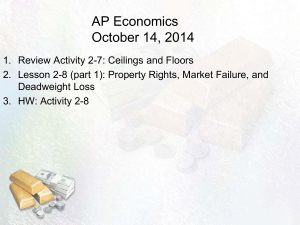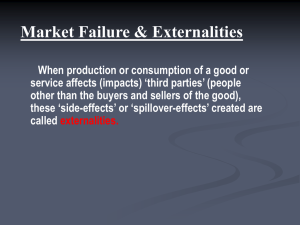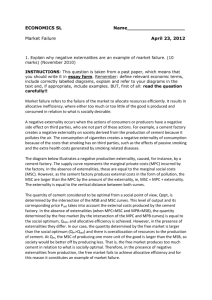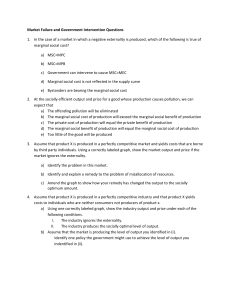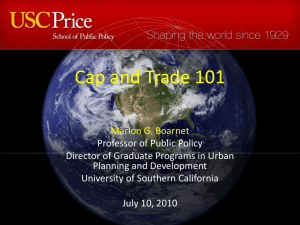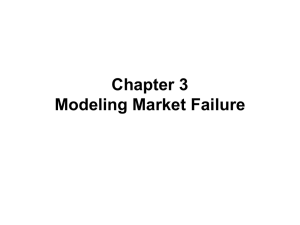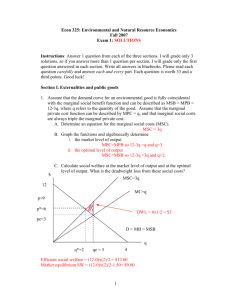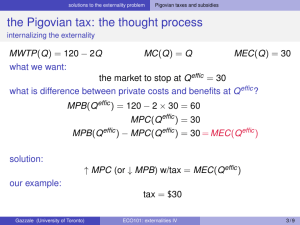MSC
advertisement
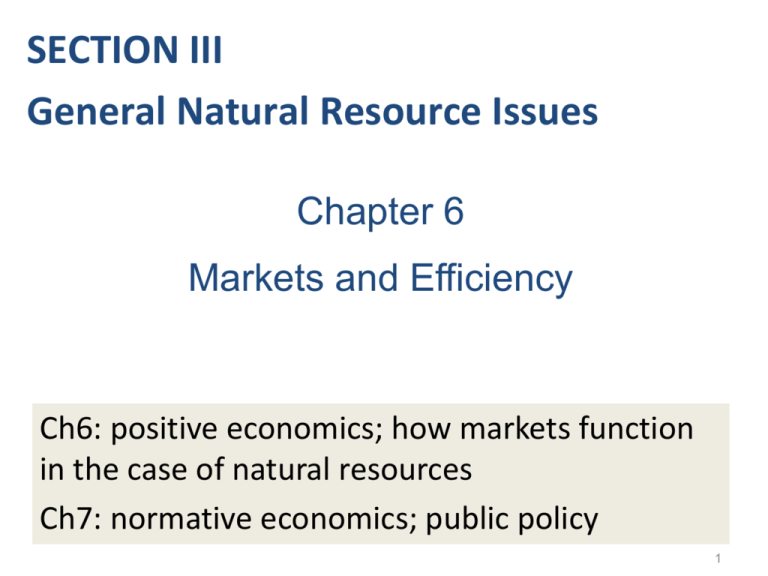
SECTION III General Natural Resource Issues Chapter 6 Markets and Efficiency Ch6: positive economics; how markets function in the case of natural resources Ch7: normative economics; public policy 1 1. Market Demand and Supply • Demand curve – downward slope illustrates diminishing marginal willingness to pay – It reflects consumers’ incomes, tastes, and other economic factors • Supply curve – upward slope reflects increasing marginal production costs – Its exact shape is related to input prices, technologies, etc. 2 2. Markets and Static Social Efficiency • If a market equilibrium means social efficiency, – then market demand curve = MSB curve: there are no sources of social value that are not registered by market participants themselves – and market supply curve = MSC curve: there are no sources of cost to members of society that are not registered in those private cost/supply curves 3 (a) External Costs a negative production externality • Consider a collection of paper mills located on a river – They produce paper: marginal supply curve is marginal private costs (MPC) curve – Paper mills emit residuals into the river which lead to damages suffered by downstream communities: downstream external costs (EC) – Marginal social costs (MSC) = MPC + EC – Socially efficient quantity and price are q* and p*; competitive market outcome is qm and pm (qm > q* , market quantity is too high; pm < p*, market price is too low) Page 91: Figure 6-3 4 (a) External Costs a negative production externality p 42 MSC = MPC + MEC S =MPC p* = 26 pm = 22 10 D = MPB = MSB 0 Review ECO324-Ch3 128 160 q* qm q of paper 5 Consumption externalities Production externalities (c) Positive (d) Negative (b) Positive (a) Negative The benefits to the rest of society of people being vaccinated before traveling abroad Noise pollution from using car stereos The benefits to the environment that arise from the planting of woodland by a forestry company Wastes being dumped into a river by a company Review ECO324-Ch3 and Ch15 (and pp.92-93 in our text) 6 (b) External Costs a positive production externality MPC a MSC = MPC + MEC b MPB = MSB 0 qm q* Review ECO324-Ch15; and pp.92-93 in our text q 7 (c) External Benefits a positive consumption externality ($ millions) MSC K p* = 175 MSB=MPB+MEB pm = 170 L MPB 0 Review ECO324-Ch15 qm = 200 q* = 210 q 8 (d) External Benefits a negative consumption externality MSC MPB 0 Review ECO324-Ch15 q* qm MSB = MPB + MEB q 9 Open-Access Resource • The resource that is open to unrestricted use by anyone who might wish to utilize it: ocean fishery, hunting, public parks… • “The Tragedy of the Commons” (Garrett Hardin, Science, Vol. 162, 1968, pp. 1243-1248): Openaccess externality that leads to overuse of the resource is the diminution in the quality of the pasture as more and more animals are out on it • Page 95, Table 6-2, public beach: the fifth visitor reduces the value of the beach to the four already there, from $20 to $18 for each one 10 Open Access and the Dissipation of Resource Rent • Public beach example: efficient visitation level is 4 visitors; benefits – costs = $80 – $48 = $32 • $32 is a return attributable to the resource itself (the beach); this is the resource rent produced by the beach • If visitation level had risen to 8 people, then benefits – costs = $96 – $96 = $0; open access had led to the dissipation or disappearance of all natural resource rent 11 Review ECO324 (slides 12-18) Chapter 3 Modeling Market Failure FYI 5. Environmental Damage: A Negative Externality • Environmental economists are interested in externalities that damage the atmosphere, water supply, natural resources, and overall quality of life 12 Modeling a Negative Environmental Externality FYI • Define the market as refined petroleum – Assume the market is competitive – Supply is the marginal private cost (MPC) – Demand is the marginal private benefit (MPB) – Production generates pollution, modeled as a marginal external cost (MEC) water pollution • Problem: Producers (refineries) have no incentive to consider the externality • Result: Competitive solution is inefficient 13 Finding a Competitive Solution Refined Petroleum Market FYI • S: • D: P = 10.0 + 0.075Q P = 42.0 - 0.125Q, where Q is in thousands of barrels per day • Since S is MPC and D is MPB, rewrite as MPC = 10.0 + 0.075Q MPB = 42.0 - 0.125Q (P means private) • Find the competitive solution and analyze 14 Competitive Solution FYI • Set MPB = MPC 42.0 - 0.125Q = 10.0 + 0.075Q • Solve: QC = 160 thousand; PC = $22 per barrel (C means competitive) • Analysis: – This ignores external costs from contamination – QC is too high; PC is too low 15 Finding a Socially Efficient Solution FYI Refined Petroleum Market • Let Marginal External Cost (MEC) = 0.05Q • Marginal Social Cost (MSC) = MPC + MEC – MSC = 10.0 + 0.075Q + 0.05Q = 10.0 + 0.125Q • Marginal Social Benefit (MSB) = MPB + MEB – Assuming no external benefits, MEB= 0, so MSB = MPB • Set MSC = MSB --10.0 + 0.125Q = 42.0 - 0.125Q --Solving: QE = 128 thousand; PE = $26/barrel 16 MSC, MPC, MPB Graph P ($ per barrel) 42 FYI Page 67 MSC = MPC + MEC S =MPC PE = 26 PC = 22 10 D = MPB = MSB 0 128 160 QE QC Q (thousands) 17 • Results of negative externality FYI --QC (160) is higher than QE (128), since the firm does not bear the full cost of its production, and so will produce more than the socially efficient quantity (overallocation of resources) --PC (22) is lower than PE (26), since MEC is not captured by market transaction 18
